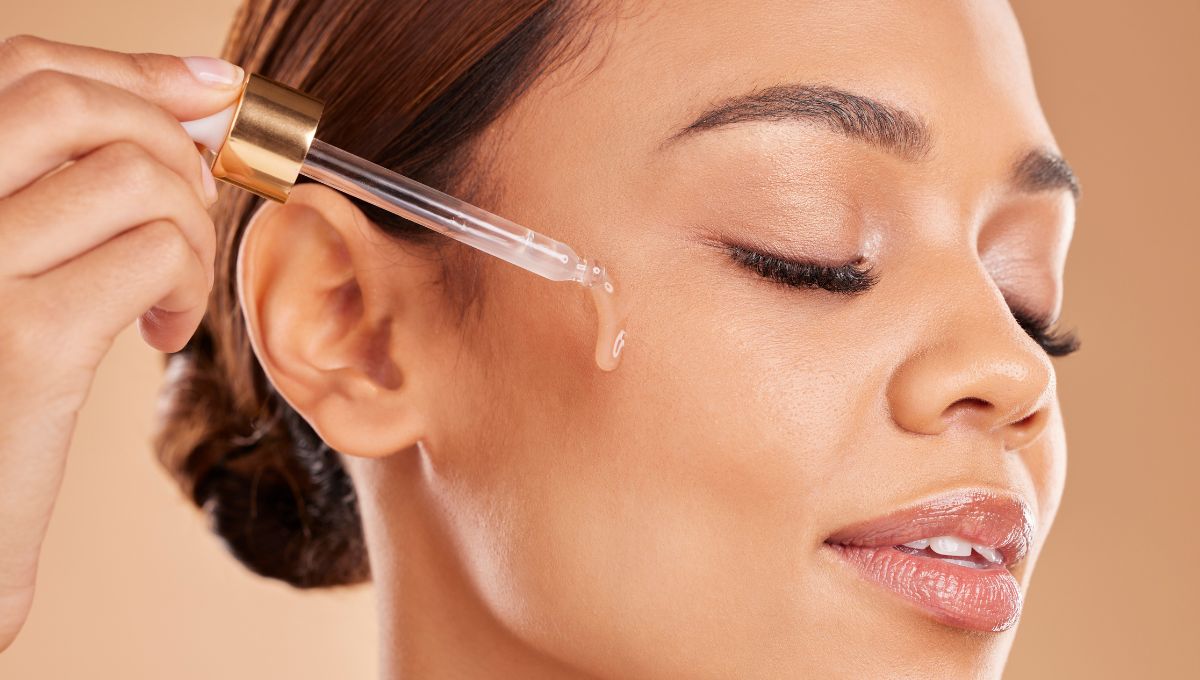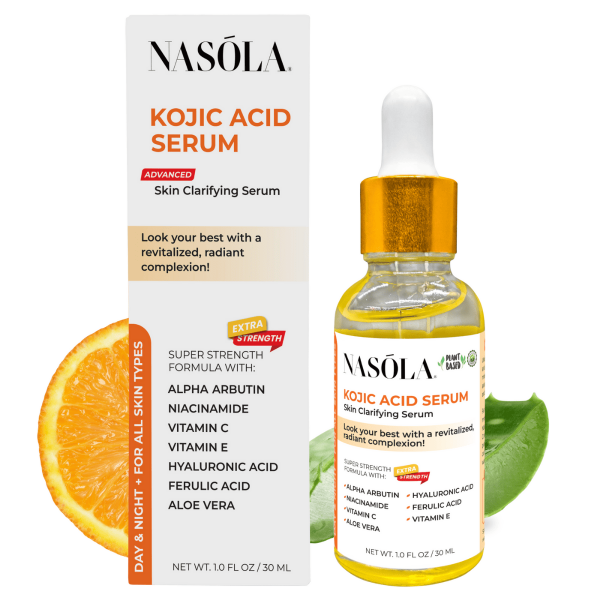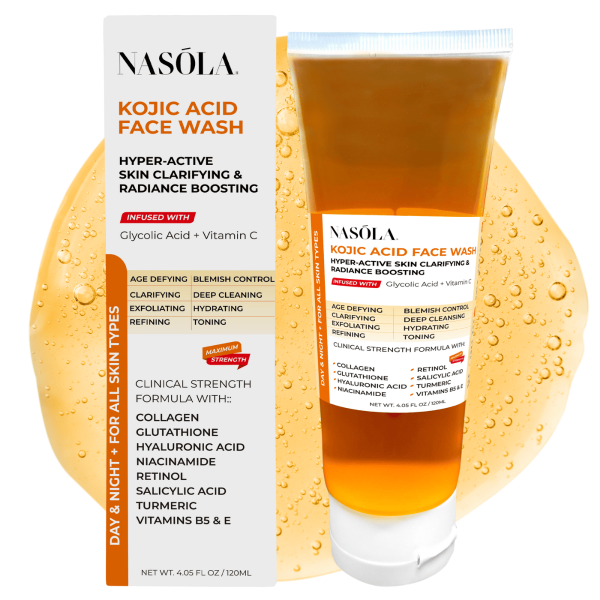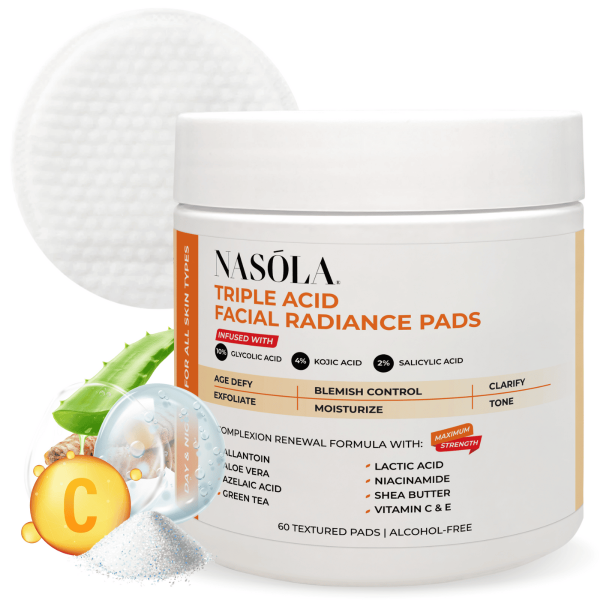Dealing with the best serum for acne scars and dark spots can feel like an emotional rollercoaster.
You’ve probably picked up more bottles than you’d care to admit, applied every drop with hope, only to be left staring into the mirror wondering… “Why isn’t anything WORKING??”
And honestly? That frustration is valid. Who wants to wait months with no results?
The good news? You don’t have to keep guessing or wasting time — or money.
In this post, we’re cutting through the noise and getting straight to what matters: dermatologist-approved serums and active ingredients that actually fade dark spots and acne scars — the RIGHT way.
You’ll also be introduced to game-changing products I love, like the Nasola Kojic Acid Serum and Triple Acid Facial Radiance Pads, so… let’s bring your glow back to life, shall we?
- The Best Serum for Acne Scars and Dark Spots: What Dermatologists Recommend
- Kojic Acid: The Ingredient That Deserves Its Own Spotlight
- AHAs and Triple Acid Solutions: The Exfoliating Powerhouses
- Best Skincare Routine to Maximize Results With the Best Serum for Acne Scars and Dark Spots
- Common Mistakes When Treating Acne Scars and Dark Spots With Serums
- How to Choose the Best Serum for Acne Scars and Dark Spots for Your Skin Type
- Dermatologist Tips to Boost Results from The Best Serum for Acne Scars and Dark Spots
- Conclusion
- Frequently Asked Questions
The Best Serum for Acne Scars and Dark Spots: What Dermatologists Recommend
If you’ve ever been haunted by the shadow of a breakout long after it’s gone, this section is for you.
Dermatologists repeatedly stress the importance of targeted serums containing potent ingredients that address melanin overproduction and inflammation.
Before we talk solutions, let’s understand what we’re really dealing with when dark marks and scars hang around.
Why acne scars and dark spots occur
Dark marks from old pimples? That’s usually post-inflammatory hyperpigmentation (PIH), not actual scars. On the other hand, true acne scars go deeper — into the dermis — creating texture changes. Here’s the kicker: both issues LOVE to overstay their welcome.
When your skin experiences trauma (like a breakout), it responds by producing excess melanin. For some, that melanin hangs out too long, turning into dark spots.
For others, the inflammation breaks down collagen, leaving behind depressions in your skin.
Different skin tones, especially deeper complexions, are more prone to hyperpigmentation. That’s why it’s key to use products that calm inflammation while fading discoloration.
Here’s what worsens the issue:
- Picking or popping pimples
- Unprotected sun exposure
- Harsh ingredients or over-exfoliating
- Inconsistent product use
Knowing the cause makes it easier to treat — effectively and safely.
What dermatologists look for in an effective serum
So — what makes a serum worth the hype? (Or even dermatologist-worthy?)
Here’s what skincare pros ALWAYS look for:
- Clinically proven ingredients: Such as kojic acid, vitamin C, and AHAs. These target both pigmentation and uneven texture.
- Proper penetration: Lightweight serums absorb best and allow actives to actually do their job.
- Non-comedogenic formulas: You want results — not more breakouts.
- Supportive hydration: Dryness sabotages progress, so hydrating ingredients are essential.
That’s exactly what makes the Nasola Kojic Acid Serum so effective. It’s lightweight but packs a punch, with kojic acid clinically shown to brighten pigmentation WITHOUT aggravating sensitive skin.
If you’ve been wondering which serum is good for acne scars and dark spots, this one is high on the list — for a reason.
Kojic Acid: The Ingredient That Deserves Its Own Spotlight
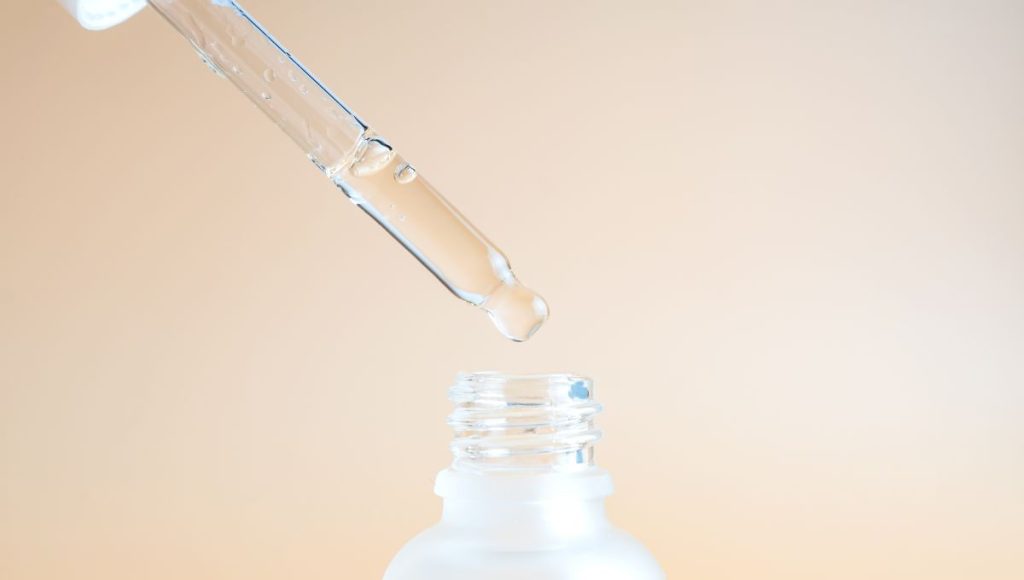
Few ingredients ignite as much praise from dermatologists as kojic acid — and trust me, it’s ✨earned✨ every bit. Mild, yet mighty, it’s brilliant for both recent acne marks and stubborn dark spots that seem to defy logic.
What is Kojic Acid and how does it work?
Let’s have a quick chemistry chat.
Kojic acid is naturally derived — either from fungi or the fermentation of rice (think Japanese sake).
But don’t let its humble origin fool you… this acid is a skin-brightening powerhouse. It works by inhibiting tyrosinase — the enzyme that fuels melanin production.
Less tyrosinase = less melanin = lighter spots. Simple.
What makes kojic acid so special for acne-prone skin is its gentle touch. It plays well with sensitive skin, and when used consistently, it can:
- Brighten dark spots without bleaching healthy skin
- Fade post-acne marks thoroughly
- Lighten overall discoloration
- Improve uneven tone over time
It’s safe to use daily (especially in properly balanced formulas). And when paired with sun protection? Results come even FASTER.
Dermatologist-approved uses of kojic acid in treating scars
Kojic acid checks all the boxes for dermatologist-recommended scar treatment:
- Versatility: It works brilliantly for oily, dry, and even combination skin.
- Synergistic combos: Dermatologists love pairing it with AHAs (like glycolic acid) for enhanced results.
- Long-term safety: As long as it’s not overused or layered with too many harsh acids, it’s ideal for daily use.
The Nasola Kojic Acid Cream is an excellent example. It’s a hydrating, kojic-rich cream that reinforces the effects of a brightening serum — and doesn’t strip or irritate. Plus, it layers beautifully under makeup or sunscreen. Total win.
AHAs and Triple Acid Solutions: The Exfoliating Powerhouses
Not all heroes wear capes. Some come in the form of exfoliants. AHAs (alpha-hydroxy acids) play a massive role in fading discoloration, smoothing texture, and preventing future scars from forming.
Lactic Acid, Glycolic Acid, and Mandelic Acid – a brightening trio
Each AHA has its superpower:
- Lactic Acid: Hydrates and gently exfoliates
- Glycolic Acid: Penetrates deeply for faster results
- Mandelic Acid: Perfect for sensitive skin
Together, they boost cell turnover — encouraging the skin’s natural regeneration process. In short: out with old pigmented cells, in with fresh, glowy ones.
What can they do?
- Eliminate surface dark spots gradually
- Smooth acne-scarred skin texture
- Unclog pores & prevent recurring breakouts
- Improve overall clarity & glow
Paired with kojic acid? You’re working magic ✨.
Dermatologist-endorsed exfoliating pads to incorporate
While scrubs can be harsh, chemical exfoliants — like AHAs — can change the game.
That’s why dermatologists favor options like the Triple Acid Facial Radiance Pads. These pre-soaked pads feature:
- Lactic + glycolic + mandelic acids
- Gentle exfoliation (with no manual abrasion)
- Shine control + texture improvement
- Travel-friendly convenience
Apply 2–3 times a week after cleansing, follow with your serum (like the Nasola Kojic Acid Serum!) — and expect smoother, brighter skin with fewer visible marks in just weeks.
Best Skincare Routine to Maximize Results With the Best Serum for Acne Scars and Dark Spots

No serum works in isolation. Building an effective routine around the best serum for acne scars and dark spots makes ALL the difference. Dermatologists agree — consistent layering and pairing of products accelerates results.
Morning routine steps for fading dark spots
Your morning routine should prep, protect, and brighten. Here’s a solid plan:
- Cleanse: Use the Nasola Kojic Acid Face Wash to gently remove buildup
- Apply serum: Follow with Nasola Kojic Acid Serum to treat pigmentation
- Moisturize: Lock in hydration so actives don’t dry the skin
- Sun protection: Finish with SPF 30+ EVERY. SINGLE. DAY.
Sun exposure will darken acne marks faster than you can say “melanin.” Protect that glow at all costs!
Evening routine to support skin regeneration
At night, your skin heals — and that’s the best time to get serious.
Here’s how you do it:
- Double Cleanse: Gentle oil cleanser + Nasola Kojic Acid Face Wash
- Exfoliating pads: Use Nasola Triple Acid Facial Radiance Pads 2–3 nights/week
- Apply serum: Always go in with that Nasola Kojic Acid Serum
- Seal the deal: Moisturize with Nasola Kojic Acid Cream for a smooth, pillowy-feel
Don’t skip nights. Every use builds progress.
Common Mistakes When Treating Acne Scars and Dark Spots With Serums
Even with top-tier products, it’s possible to sabotage your own results. Dermatologists see it all the time — especially with over-eager routines.
Over-exfoliation and ingredient incompatibility
Layering multiple acids sounds efficient… but can result in barrier damage, redness, and inflammation — which leads to more pigmentation.
- Don’t mix strong retinoids with AHAs unless a derm says so
- Stick to max 3 active ingredients in one session
- Alternate: Use AHAs one night, kojic another
- Always moisturize + protect with SPF afterward
Play smart — not aggressive.
Inconsistent usage and product hopping
If you switch products weekly or skip days, progress stalls.
Here’s what helps:
- Stick with a routine for 4–12 weeks before judging results
- Avoid trying 5 new products at once
- Take weekly progress pics (not daily!)
- Be gentle and trust the process
Remember: your skin didn’t get this way overnight… so healing it will take time — consistency is KEY.
How to Choose the Best Serum for Acne Scars and Dark Spots for Your Skin Type
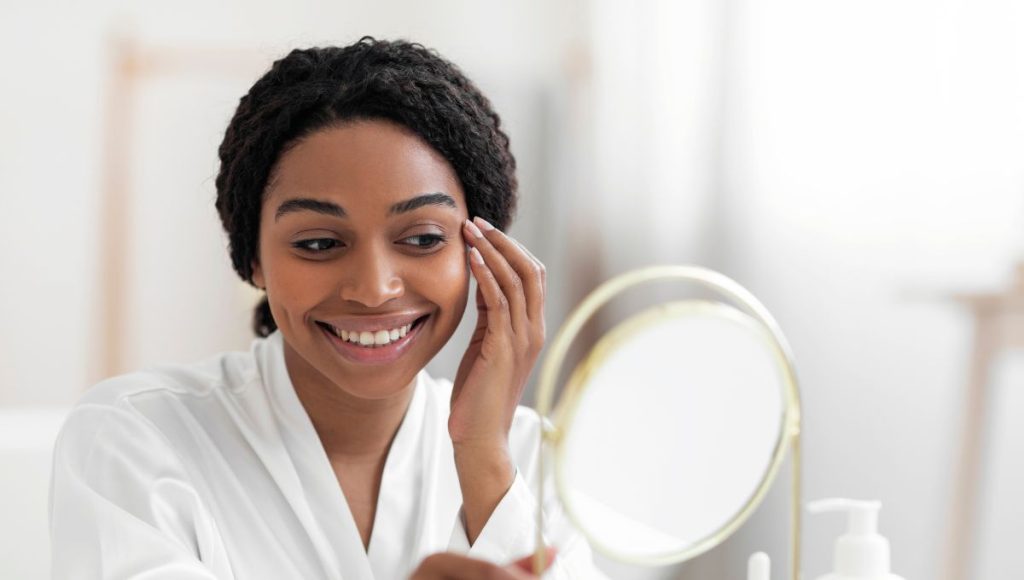
Skin is unique. What works for one person may dry another out. Dermatologists advise choosing serums based on your skin type and tolerance level.
Sensitive skin: Go gentle with kojic acid and ceramides
Harsh retinols and aggressive peels might be too much.
Instead:
- Choose fragrance-free, lightweight options
- Use Nasola Kojic Acid Serum once daily
- Pair with a ceramide-rich moisturizer
- Always patch test first, even with gentle actives
Less is more. Especially on reactive skin.
Oily and acne-prone skin: Pair acne-fighting with skin-brightening
You need actives that won’t clog pores—but still fade marks.
- Opt for non-comedogenic products like Nasola Kojic Acid Serum
- Use Nasola Triple Acid Facial Radiance Pads up to 3x/week
- Avoid creams with heavy oils or waxes
- Stick to lightweight hydration + consistent cleansing
This balance keeps breakouts at bay AND evens out stubborn spots.
Dermatologist Tips to Boost Results from The Best Serum for Acne Scars and Dark Spots
Want even better results from the best serum for acne scars and dark spots? These tips work alongside any solid routine to seriously speed up the fading process.
Sun protection is non-negotiable
Dermatologists unanimously agree — UV exposure undoes progress and worsens pigmentation.
- Use a broad-spectrum sunscreen every single day
- Reapply every 2 hours if you’re outdoors
- Wear hats + sunglasses for extra defense
- Choose mineral sunscreens if you’re sensitive
Even the best ingredients need this protection to work well.
Layer skincare properly for best absorption
The order of application matters.
- Start with cleanser
- Apply treatment serums (like Nasola Kojic Acid Serum)
- Follow with moisturizer
- Finish with SPF or night cream
Proper layering helps actives penetrate better and minimizes potential conflicts or irritation.
Conclusion
Finding the best serum for acne scars and dark spots isn’t just about luck or trial and error; it’s about understanding ingredients and trusting solutions dermatologists stand behind.
Ingredients like kojic acid, glycolic acid, and mandelic acid work powerfully — especially when used in formulas like the Nasola Kojic Acid Serum, Nasola Kojic Acid Cream, and Nasola Triple Acid Facial Radiance Pads.
With consistent use, patience, and a smart skincare routine, you can say goodbye to frustrating spots and hello to smooth, even-toned, confident skin.
So set a reminder, give it time, and let your skin reveal its best version — one layer at a time.
Frequently Asked Questions
The Nasola Kojic Acid Serum is widely favored by dermatologists and users alike. It contains kojic acid, a gentle yet effective ingredient that fades pigmentation without irritating sensitive skin.
Using brightening agents like kojic acid, glycolic acid, and mandelic acid—found in Nasola Triple Acid Facial Radiance Pads and Nasola Kojic Acid Cream—alongside sun protection and consistent routines help speed up fading significantly.
Yes, combining products like the Nasola Kojic Acid Serum and Nasola Triple Acid Facial Radiance Pads is safe, but limit exfoliation to 2-3 times weekly. Always follow with hydration.
With proper application, expect to see visible improvements in 4–6 weeks. This depends on the active ingredients used and your skin type.
You can do both, but if using in the morning, apply sunscreen afterward. Nighttime use allows deeper skin recovery.
Absolutely. The Nasola Kojic Acid Face Wash preps the skin perfectly for absorption of serums and creams.
Some users may experience mild dryness or irritation initially. Patch test, moisturize, and start slowly until your skin adjusts.
Serums like Nasola Kojic Acid Serum deliver concentrated ingredients deeper. Creams like Nasola Kojic Acid Cream help lock in moisture and enhance those effects.
While primarily helpful for pigmentation, kojic acid can reduce discoloration around deep scars, making them less noticeable. For texture improvement, dermatologists may recommend combining it with professional treatments.
Yes! The Nasola Kojic Acid Face Wash, Nasola Kojic Acid Serum, Nasola Triple Acid Facial Radiance Pads, and Nasola Kojic Acid Cream are designed to complement each other in one streamlined routine.

